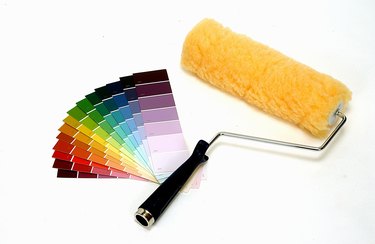Things You'll Need
Extra-fine grade sanding block
Tack cloth
Paint tray
Paint roller
Satin paint

Flashing is uneven pigment saturation often seen in satin coats of paint. A number of problems can cause flashing. Uneven porosity on the substrate may cause more pigment to absorb in some places than others. Poor-quality paint or paint rollers may result in uneven application of the paint and result in thick and thin areas. No matter the reason, most flashing can be fixed with a second coat of satin paint.
Step 1
Sand the wall with extra-fine grain block sandpaper. Sand just enough to roughen and even out any areas of thick paint on the wall.
Video of the Day
Step 2
Wipe the wall down with a tack cloth to remove all sanding dust. Use an industrial vacuum to clear up any sanding dust on the floor. Dust particles are small, easily airborne and prone to landing in finish coats. If you do not have a vacuum, sweep once. Then allow the dust to settle for 15 minutes and sweep again.
Step 3
Pour a new batch of paint into a paint tray. Use high-quality paint and do not dilute. Low-quality or diluted paint often goes on unevenly. Also, different concentrations of pigment create flashing.
Step 4
Apply a fresh coat of paint on the wall. Dip the roller in the paint, then roll it on the tray. Getting rid of excess paint this way will prevent creating thick and thin layers of paint that result in flashing in the finished coat. As you paint, work quickly so you are always leading with a wet edge. Paint from one end of the wall clear across to the other. Don't try to join up dried sections. Painting over partially-dried paint creates uneven layers.
Tip
Quality latex satin paint is least likely to suffer from flashing, according to Dunn Edwards Paints. Invest in quality products. A high-quality paint roller is less likely to apply paint unevenly and result in flashing in a satin coat.
Video of the Day